Marine Iguana Foraging Underwater for Algae
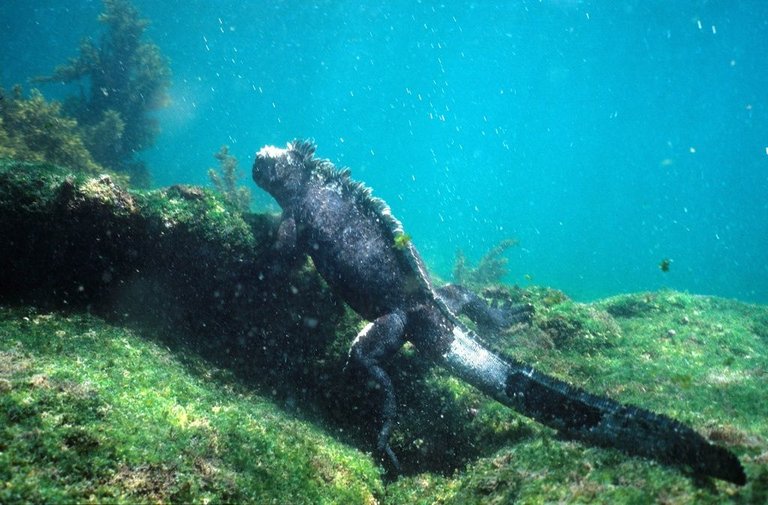
Derek Keats from Johannesburg, South Africa. Used under CC 2.0 license.
The marine iguanas of the Galapagos (Amblyrhynchus cristatus) are an essential part of the Galapagos ecosystem. They are an exquisite example of species adaptation. They feed almost exclusively underwater and their diet consists almost entirely of green and red algae. Because of their distinct feeding habits, the marine iguanas have acquired certain physical traits that allow them to survive. It took millions of years for these adaptations to evolve.
It is believed the marine iguana arrived in the Galapagos as a terrestrial animal.
Terrestrial Iguana Sunning Itself in Curacao
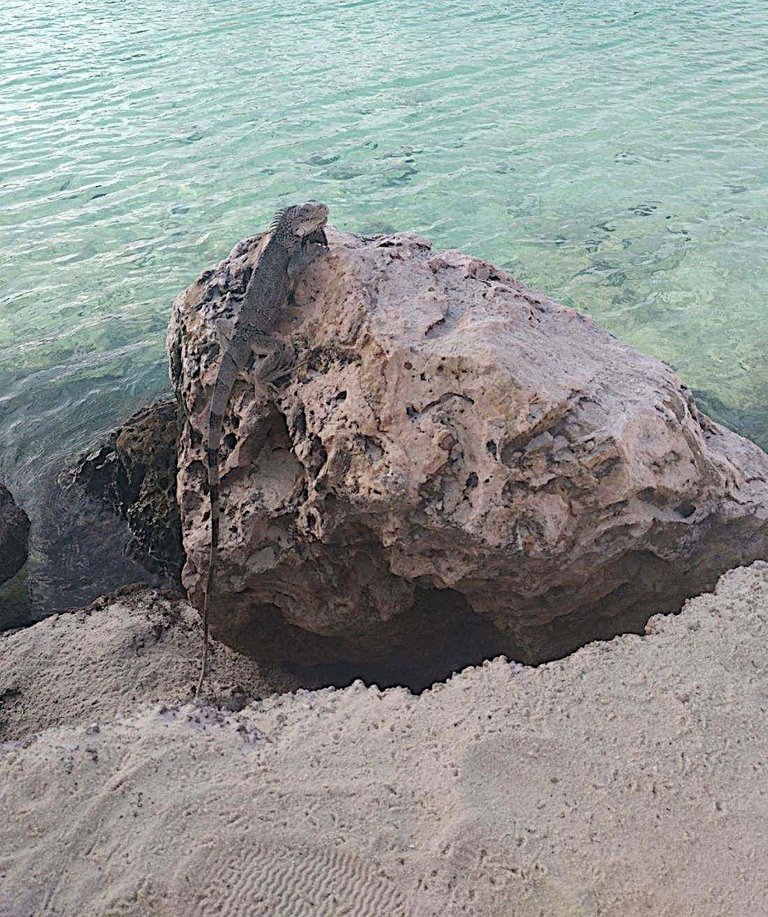
agmoore
Perhaps the iguana arrived on a floating island of vegetation. There are species of iguana in the Galapagos that live and feed on land. But the marine species (Amblyrhynchus_cristatus) acquired characteristics that allowed it to tolerate cold sea water, consume salt with its food, digest algae, and adapt to a fluctuating food supply.
In 1835, When Charles Darwin visited the Galapagos he thought the marine iguana was 'remarkable'. He also thought it was 'hideous looking', and 'sluggish'. Since Darwin's visit, evolutionary biologists have noted the unusual speciation of the marine iguana. It is distinguished from land-feeding iguanas in several ways.
Tolerating Cold Sea Water
The marine iguana is cold blooded, which means it does not generate its own body heat but depends on the environment for thermal regulation. In order to tolerate the cold waters in which they feed, the iguanas lower their metabolic rate to use less energy. This allows them to stay in the water longer and forage for algae.
Here is a YouTube video by Mark Hatter that shows the iguana foraging for algae underwater.
After twenty minutes, or perhaps as long as an hour, they have to return to shore to warm up. They sun themselves, as iguanas do. However, they also have developed a distinct behavior which allows them to conserve body heat more efficiently, social thermoregulation. This involves huddling together in a pile. They do this especially at night.
Marine Iguanas Piling on
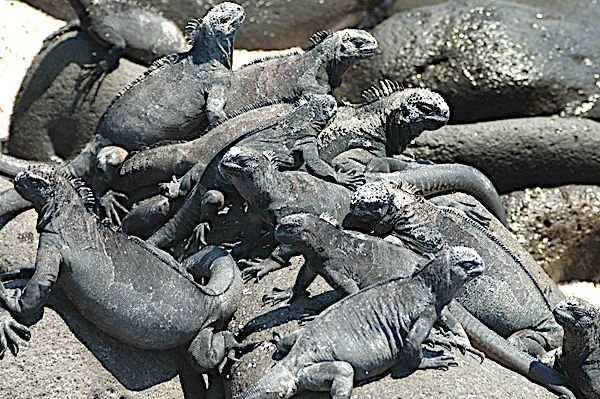
Aquaimages at English Wikipedia. CC 2.5 license
Expel Salt Consumed With Food
Because the marine iguana feeds in salt water, it ingests large quantities of salt. If it couldn't expel this salt, it would die of dehydration, so it has developed a large cranial salt gland for expelling salt. With this gland, they are able to "sneeze out" the salt.
Here is a YouTube video that shows the iguana 'sneezing' salt:
After sneezing, the iguana is often left with a head covered in what appears to be white frost, but is indeed salt:
Salt on the Head of a Sunning Marine Iguana
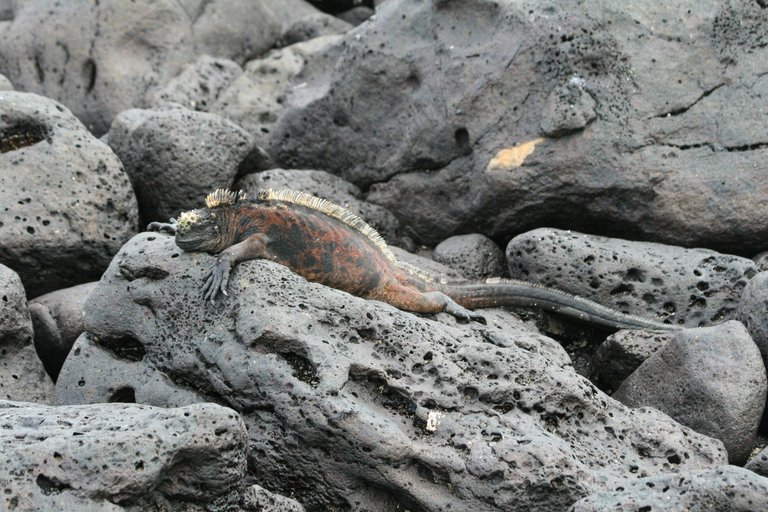
RAF-YYC from Calgary, Canada. CC 2.0 license.
Adapt to Fluctuating Food Supply
One of the most remarkable adaptations of the marine iguana is its ability to shrink, in response to reduced food resources. This shrinking isn't just a reduction in width, but actually allows the iguana to become shorter. They may be as much as 20% shorter in times of food scarcity. It is thought they are able to shrink partly because they reabsorb bone.
Here is a Youtube video that explains the ability of the marine iguana to shrink:
As researchers compare the size of marine iguanas on different Galapagos islands, they note that there is great variation. The larger iguanas are found on the islands with greatest amount of available algae.
Digest Algae
The marine iguana has a very specific diet: algae. The specificity of this diet has led to an adaptation in its gut microbiome. An article in Animal Microbiome (Yes! there is a journal dedicated specifically to the animal gut microbiome!) explains that there is a symbiotic relationship between gut bacteria and the marine iguana. This bacteria allows the iguana to digest algae, but only green and red algae. A quote, "The functional microbiome profile unravels the symbiotic relationship of the gut microbiome with the macrophytic algae-consuming marine iguanas."
The iguanas live on different islands in the Galapagos. It's interesting that, while all the marine iguanas share an essential gut microbiome composition, there are variations in this microbiome, island to island, that correlate to the availability of algae. This correlation and availability of algae is associated with variations in water temperature. The algae upon which the marine iguana feeds thrives in colder water.
Marine Iguana on Isabela Island
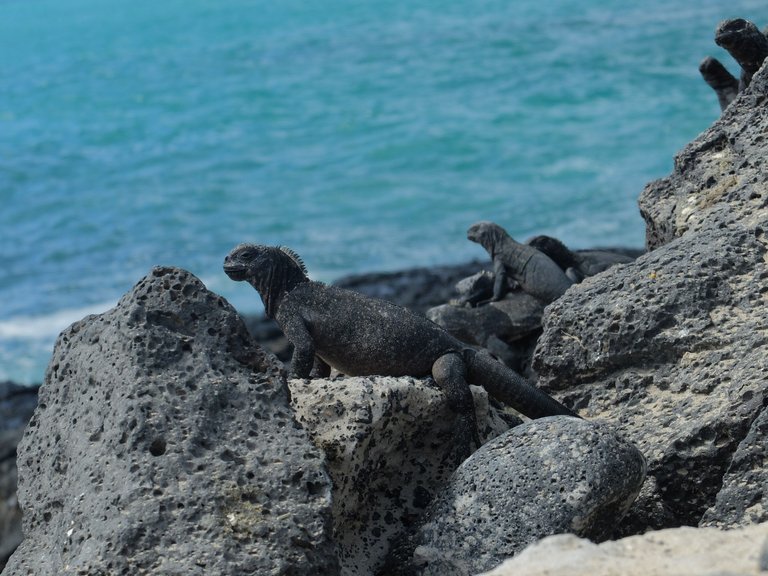
Time Krieger. Used under CC 4.0 license. The largest iguanas area found on Isabela and Fernandina islands
Here is relevant quote from Animal Microbiome, "Differences associated with the diet were evidenced by the differential abundance of microbial metabolic pathways in the marine iguana gut between locations."
It was also found that availability of algae and the size of the marine iguana correlated to water temperature. Another quote, "Sea surface temperatures are negatively correlated with the length of algae pastures and the size of marine iguanas".
It's already been asserted in this blog that the marine iguana has a highly specialized diet, adapted to the ecology of the Galapagos. It is suggested by evolutionary biologists that the iguana developed its unique traits in response to the harsh environment of the Galapagos.
The Galapagos marine iguana, over millions of years, evolved the ability to forage in the one area where food was abundant: the sea. If something were to happen to that food source, if the highly specialized adaptation was no longer useful, then those millions of years of evolution would not serve their purpose.
This is what seems to be happening today. There has been a dramatic decrease in the marine iguana population, and scientists are puzzling over the cause. Recently, one explanation has been offered: disappearing algae because of changing water temperatures.
Here is a rather lengthy YouTube video that examines the puzzle:
Historically, water temperature around the Galapagos were cooled by the Humboldt Current. This current flows up to the Galapagos from Antarctica. Periodically, a warmer current, El Nino, sweeps through and modifies the cooling temperatures of the Humboldt.
Humboldt Current Flowing Up South American Coast
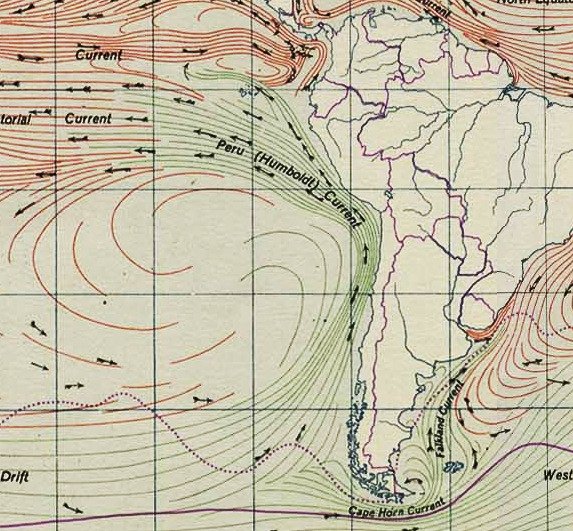
US army soldier. Public domain.
In the periods of El Nino presence, algae do not thrive. The iguana's shrinking adaptation allows it to survive these deficits in nutrition. However, in recent years El Nino has occurred more frequently, and the iguana population does not have enough time to recoup between the current's appearances. According to a 2023 study out of Yale University, "Climate change is now a major factor in formation of El Nino".
It is estimated that up to 90% of the marine iguana population has died off because of starvation and overheating in the warmer waters.
Is Climate Change Killing off the Marine Iguanas of the Galapagos?
There is no definitive answer to this question. There are other factors that may influence iguana survival. Cats, for example, imported by humans, feed on iguana babies. And the hawk, an indigenous predator, feeds on the iguana. But there is no getting around the fact that iguanas shrink when there is an algae deficit. And there is no getting around the fact that the algae supply has disappeared along much of the Galapagos coast.
Iguanas are starving to death.
Thank you for reading my blog. Peace and health to all.
Selected Sources Used in Writing This Blog
https://www.eduardoinfantes.com/marine-iguanas-galapagos-islands/
https://www.nhm.ac.uk/discover/shrinking-galapagos-marine-iguanas.html
https://oceana.org/marine-life/marine-iguana/
https://www.galapagos.org/about_galapagos/biodiversity/
https://www.gogalapagos.com/charles-darwin-galapagos/
https://thesea.org/how-do-marine-iguanas-conserve-heat/
https://bio.research.ucsc.edu/~barrylab/Lisa/PDFs/Hazardchap06proof.pdf
https://oceana.org/marine-life/marine-iguana/
https://www.nhm.ac.uk/discover/shrinking-galapagos-marine-iguanas.html
https://www.jstor.org/stable/48718472
https://animalmicrobiome.biomedcentral.com/articles/10.1186/s42523-022-00218-4
https://galapagosconservation.org.uk/species/marine-iguana/
https://e360.yale.edu/digest/el-nino-climate-change
https://blueplanetsocietystore.com/blog/marine-iguanas-the-oceans-forgotten-victims/
https://www.galapagosislands.com/nature/wildlife/reptiles/marine-iguana.html

